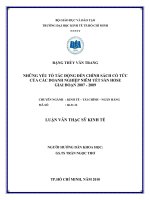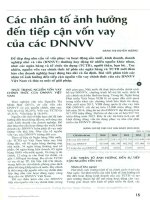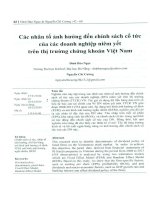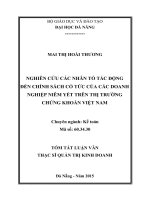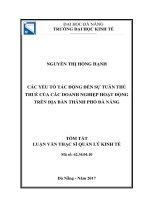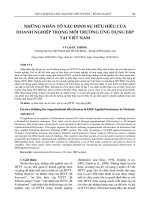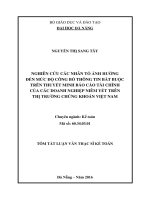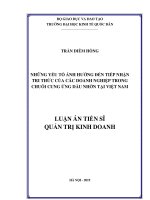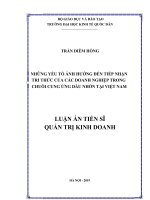Những yếu tố ảnh hưởng đến tiếp nhận tri thức của các doanh nghiệp trong chuỗi cung ứng dầu nhờn tại việt nam tt tiếng anh
Bạn đang xem bản rút gọn của tài liệu. Xem và tải ngay bản đầy đủ của tài liệu tại đây (177.51 KB, 14 trang )
1
2
CHAPTER I - GENERAL INTRODUCTION TO RESEARCH
all members must consider keeping their position in negotiating,
keeping business and administration secrets, etc to maintain power
in cooperation.
1.1. Reasons for choosing the topic and research context
- Previous studies on KA in SC are mainly conducted in the context
1.1.1 Reasons for choosing the topic
of developed countries or in enterprises with partners in developed
acquisition (KA) is very
countries (for example, Zhenxin Yu et al, 2001; Benton and Maloni,
important for each organization in general and for the members in
2005; Shih et al., 2012) or in the industry favoring research and
the supply chain (SC) in particular. According to Grant, 1996b,
development (Grant 1996b, Shih et al., 2012). In those cases, new
"Knowledge is considered the most important strategic resource". In
technology and knowledge are the key to cooperation, sharing and
order to survive and succeed, businesses must constantly expand and
KA. Meanwhile, even in SCs that are not in favor of research and
enhance their knowledge, which depends on internal knowledge
development, the demand for KA from partners in SC is also vital
sources as well as the ability to integrate knowledge from outside.
and should be implemented regularly and continuously.
Grant and Charles (1995) also emphasized that knowledge can be
- KA have a distinction between different types of businesses, such
integrated from outside through cooperation with other parties.
as Grant, (1996b), Shih et al., (2012) studied businesses in the
The research on KA is no longer new, there have been many studies
direction of development researches or studies by Zhenxin Yu et al.
on this issue in Vietnam and all over the world, but there are still
(2001); Benton and Maloni, (2005); Phan et al (2006), Shih et al,
some shortcomings:
(2012), Hong and Nguyen (2013) focused on joint-venture
- KA itself is a process and ever-developing. Huber (1991) argued
enterprises and multinational enterprises. Thereby, it can be seen that
that learning and KA "change the scope of its potential behaviors
characteristics of different types of enterprises can also affect and
and potentially lead to better results".
create differences in KA of enterprises. However, previous studies
- KA in SC has many characteristics, however, previous studies have
have not mentioned or had any empirical studies to prove this.
not fully mentioned or reflected all these characteristics. They are (1)
- The specific business environment in Vietnam that is different
SC members exercise KA as both learning organizations and
from the world business environment can lead to different levels of
businesses with close and cooperative relationships in a unified
impact on KA factors. This requires more empirical research to
manner to bring products from production to consumption.
verify.
However, the existing studies on KA of enterprises are only in either
In practical terms:
side without research around the sharing and KA integrating both
- Receiving and sharing of knowledge in learning organizations in
In theory: Sharing and knowledge
sides. (2) When sharing and exercising KA among members of SC,
3
4
general and in the enterprises in supply chain in particular in
and development and is highly universal. Upstream Lubricant SC:
Vietnam has not truly been paid attention and has not brought about
Vietnam has not yet been able to produce the main materials for the
positive results. In the Vietnamese market, there are many sectors
production of lubricants. Base oil and additives must be imported
and domestic products that are successfully dominating the market,
from a few providers in the world. Manufacturers and auxiliary
especially in the downstream of SCs. These advantages may no
suppliers: Depending on the quality of lubricants, manufacturer will
longer exist if the competitive advantages of Vietnamese SCs are
choose and test the most cost-effective mix to put into production.
unsustainable and unique. Enhancing the mutual KA among
Therefore, the competitive advantage of manufacturer is not from
enterprises in the Vietnam SC in order to develop the unique and
research and development, but from cost savings and lowering of
hidden knowledge of its members into the knowledge of the chain
production costs. In fact, large lubricant manufacturers in Vietnam
and at the same time strengthening the cooperation and solidarity
have been positioned in the market, cooperated closely with each
relationship within Vietnam SC is a solution to improve sustainable
other and with providers to buy large amount of raw materials with
competitiveness.
low wholesale prices to reduce costs, thus input not a competitive
- So far in Vietnam, there seems to be no empirical studies on
advantage among SCs. Downstream SC lubricant: The difference of
sharing and KA in SC, especially studies on KA in SCs that are not
lubricants SC in Vietnam is the distribution system. In each segment,
in favor of research and development are very popular among
the manufacturer is also the leader of the distribution system. The
Vietnamese enterprises. In fact, studies on KA in SC has only been
major lubricants on the market are trying to participate in all market
found in developed countries. Studies on KA of enterprises in
segments, but only have advantages in some segments. Domestic
Vietnam mainly focus on enterprises with foreign capital. An
lubricant companies often focus on products of average quality in
empirical study is needed to determine the similarities or differences
segments of Group (1) lubricants for motorcycles, cars and Groups
between the factors that affect the KA of enterprises in the specific
(2) lubricants for trucks and buses. The supply of lubricants in group
conditions of enterprises in SC in Vietnam.
(3) for industrial machinery and group (4) of marine lubricants faces
Stemming from the above reasons of theory and practice, the author
with many technical barriers that not all domestic lubricants can
has selected the theme ‘Factors affecting KA of enterprises in
meet.
lubricant SC in Vietnam' as the research topic of the thesis. This
Secondly, in lubricant SC, the need to know and update general
topic is both significant in theory and very meaningful in the
knowledge about trade items, machinery, practices and knowledge in
management practice of the managers of enterprises in Vietnam.
product management and distribution, etc throughout the system is
1.1.2 The research context is that Vietnam lubricant SC has met the
always set. Since lubricants are ancillary products associated with
set criteria. First of all, this is a typical SC, not directed to research
each generation of equipment, machinery, means of transport, etc,
5
6
the need to exchange information, update knowledge to enhance
Objects of research: are the theories and practices of factors affecting
strength, support relationships in the SC system is an essential
KA of enterprises in lubricant SC in Vietnam.
requirement.
Research scope:
Next, in addition to representativeness, typically for non-research-
- Object of study: is the lubricant SC of a lubricant manufacturer in
based SCs but still in need of KA, the choice of lubricant SC also
Vietnam, Petrolimex lubricant SC. This is the most universal SC,
has some advantages, which are essential in research and survey
representing all the inherent characteristics of lubricant SC in
organizations. The lubricant SC is a traditional SC, with diversified
Vietnam. The decision to "analyze the members of the SC of a single
members, distinguishable materials and products as well as cash
lead company to avoid the confounding effects due to the influence
flow and information, determinable location and position of
of companies operating in many different SCs" (Hult et al., 2004)
companies participating in SC, so that each member of SC can be
had been posed in the study of Qile He et al (2013).
determined as the KA unit or knowledge transfer unit.
- Research space: Study and survey of enterprises in Petrolimex
1.2. Objectives of the study
lubricant SC in the whole country.
- Research period: study of KA activities of enterprises in
- Determine the number of factors affecting KA of enterprises as a
Petrolimex lubricant SC in the period of 2013-2017.
member of lubricant SC in Vietnam.
- Assess the impact of KA factors of enterprises as a member of
1.4. Research Methods
lubricant SC in Vietnam.
The thesis combines the use of both quantitative and qualitative
- Show the difference in KA among different enterprise groups in
research methods. With each research method used in the thesis,
lubricant SC in Vietnam.
there are two steps: data collecting and data processing.
- Show the change in the impact level of factors affecting KA of a
Collect and process secondary data to propose solutions to improve
learning organization when studying in the context of an enterprise
KA effectiveness of SC members.
in SC in Vietnam.
Collect and process primary data:
- Based on the research results of the thesis and the synthesis of
Collect and process primary data in qualitative research, 1 group
information related to difficulties and barriers that enterprises in
discussion and in-depth interviews with 3 SC members were carried
lubricant SC in Vietnam face when KA is from outside, propose
out. Primary data obtained is the basis for completing observed
some management suggestions, improving KA of enterprise in
variables and Questionnaires. At the same time explain the
lubricant SC in Vietnam.
conclusions obtained from quantitative research and enrich
1.3. Object and scope of the study
management solutions.
7
8
Collection and processing of primary data in quantitative research:
verification model, and Detects 06 factors affecting the KA of the
are done in the following order:
enterprises in SC. The thesis also affirms the compatibility of the set
Questionnaires design: original English questions were translated
of measurement criteria affecting the KA of the appropriate learning
into
understanding,
organization of enterprise in SC and vice versa; shows the
questionnaires will be translated back into English. These questions
differences and consistency between a learning organization and a
were revised and supplemented during the qualitative research
member in SC.
process and continued to be revised before the officially handed out.
-The study has proved that the new measurement criteria are
The correction of questionnaires was based on model changes and
appropriate and statistically significant, which is the criterion "Pay
the addition or reduction of observed variables to match the actual
attention and spend time searching for information and knowledge
conditions of the case study of the lubricant SC in Vietnam
from partners" for the independent variable "The ability of employee
Research sample design following the method was used by Hult et
to learn" and the criterion "Regularly exchange information and
al. (2004) and Qile He et al (2013). In particular, the author used SC
knowledge with partners" for the "Enterprise Culture" variable.
of a single lead company as a sampling frame. The sample size is
- The research shows that there are differences in KA among
calculated according to the method proposed by J.F Hair et al.
enterprises: inside and outside a corporation integration, among
(1998).
enterprises with different types, capital scale, labor, location and
Collection of data through mail survey. Subjects answering
time of cooperation.
Vietnamese.
To
ensure
uniformity
in
questionnaires are managers of enterprise in SC. The survey was
mailed and/or emailed as a survey by Petrolimex Petrochemical
Corporation – the leading enterprise of Petrolimex lubricant SC.
Data processing Before being put into statistical processing, data
will be filtered and encoded. In addition to the description statistics,
the data is analyzed with statistical processing software SPSS 20.
1.5. New contributions of the thesis
Contribution to reasoning
- From a knowledge-based management perspective, an enterprise
participates in SC and is both an independent learning organization
and an enterprise in SC. The thesis proposes a research and
Contribution to practice
- Identify and indicate the impact level of the factors affecting the
KA of the enterprises in SC. The internal forces of enterprise such as
“enterprise culture”, “enterprise’s investment for training” and
“Business cooperation contacts” have the strongest impact on KA.
Individual capacity in enterprise does not significantly affect KA. In
Petrolimex lubricant SC, KA of enterprise depends on the policy and
the interest of the head of the enterprise.
- Provide management suggestions to enhance new external KA.
They are (1) Creating a culture of learning, acquiring new
knowledge from outside (2) Policy and commitment to resources for
9
10
training, especially the enterprise at the center of SC. (3) Enriching
resources that other competitors lack allow enterprises to receive
the forms of knowledge sharing in line with industry characteristics
economic benefits virtually resemble monopoly (Wenerfelt, 1984).
(4) Enhancing exchanges and cooperation in many fields of SC (5)
Therein, knowledge is the source of resources to develop and
Restricting the use of power (6) Having clear, long-term, respectful
maintain a competitive advantage, hence equals an irreplaceable
and equal cooperation policies for all partners (7) Promoting brand
resource (Barney, 1991). The theory of resources sees knowledge as
credibility, spreading culture and accumulated knowledge of
the most important strategic resource (Grant, 1996), which is a source
Petrolimex in all lubricant SC.
and a basis for developing knowledge-based management theory.
- Open up the next research directions, which are researches under
the following conditions: (1) Differences in industry characteristics,
scale, functions, etc (2) KA of members in vertical integration (3)
Analysis of the impact of the factor groups affecting KA in SC (4)
The effectiveness of KA in SC.
2.1.1. Knowledge-based view
From the knowledge-based view (KBV), Kogut & Zander (1992)
argue that knowledge, including information and expertise held by
individuals and expressed in codes of conduct that following which,
members work together in a social community. Under this
perspective, SC management will be more abundant and effective
CHAPTER 2 THEORETICAL BACKGROUND, RELATED
when approached under the perspective of knowledge-based
RESEARCH
OF
management. The boundaries of an organization are defined by the
KNOWLEDGE IN THE SUPPLY CHAIN AND RESEARCH
limit of knowledge and the ability to bind knowledge between the
MODEL PROPOSAL
creator and the user. The organization plays a role in clarifying,
OVERVIEW
ON
RECEPTION
amplifying and integrating the knowledge created by individuals into
2.1. Theoretical basis of KA of enterprises in SC
According to management theory based on resources, valuable,
scarce, inimitable and irreplaceable resources (Barney, 1991) and the
organization's core ability or capacity are sources of sustainable
competitive advantage for enterprises. This theory suggests that
resources are heterogeneous and cannot move freely among
enterprises. Resource theory conceives the success or failure of
enterprises depends on the resources owned by enterprises (Barney,
1991; Grant, 1997; Reid & ctg, 2001). At the same time, owning the
general knowledge. General knowledge is a means assisting
individuals in communicating information with each other.
Knowledge can be integrated from external sources through a
network of contacts beyond the enterprise border.
The traditional KBV school emphasizes the importance of
knowledge to create a competitive advantage, thus the learning of
the organization explains the knowledge creating process in an
organization. Learning in an organization refers to KA as part of the
learning process, in which individuals acquire knowledge, and
11
12
organizations create an environment for individuals to acquire that
Panayides & Venus Lun, 2009, Dang Van My, 201). Research
knowledge. KA is the first element in the organization's learning
direction on partnership management in SC, showing that
process (Huber, 1991). These variables are a prerequisite for studies
partnership is a good environment to share and acquire knowledge
of factors affecting an organization's KA.
among partners (eg Hult et al, 2004; Modi & Mabert, 2007; Pedroso
2.1.2. SC and SC administration
& Nakano, 2009; Shih et al., 2012). In another aspect, the power
SC is a collection of three or more entities that are directly related to
factor and the interdependence between partners in SC are proved to
the flow of products / services, finance and information from
have an effect on KA (Caniels & Gelderman, 2007 and Qile He et
suppliers of raw materials to customers and vice versa (Mentzer et
al., 2013). KA in SC is also found as a consequence of studies of SC
al., 2001). ). According to Christopher (2005) SC manager is to
efficacy (Rauniar et al., 2008; Lawson et al, 2009; Cao and Zhang,
manage multidimensional relationships between buyers and sellers
2010). Conversely, only going into analyzing some image elements
in order to give customers higher values at lower costs in SC.
(Emerson, 1962; Caniels & Gelderman, 2007; Qile He et al., 2013)
Effective management of SC shows through the increasing flow of
or creating a good environment for KA in the organization (Hult et
material and cash into the chain. However, in order to do this, the
al, 2004; Modi & Mabert, 2007; Rauniar et al, 2008; Shih et al.,
information flow needs to be smooth and moreover, the role of the
2012), but have yet to find general studies on the factors affecting
central enterprise in choosing and encouraging information sharing
KA in SC.
among members is significant to create a common effect in SC.
There are also some studies examining the members of the chain
With a traditional SC, product brand owners are the market leaders
from the perspective of a member of the KA organization from
and have an important role in sharing and KA among chain members.
outside, from the perspective of the organization (Spekman et al.,
2.1.3. KA in SC
Very few studies have taken KA in SC as the main research object, it
is often mentioned in a discrete, insignificant way and serves for
other purposes. Studies on SC effectiveness show that chain
efficiency depends greatly on the truthfulness and accuracy of
information. Accordingly, there has been a class of researches on
information flow management in SC. In particular, KA - a more
"deep" and "rich" form of information, is referred to as a
consequence (for example, Hult et al., 2004; Modi & Mabert, 2007;
2002; Hult et al., 2004; Mohammad et al, 2014) but still sporadic.
2.2. Overview of studies on the factors affecting KA
Development of Huber's theory (1991) on organizational learning,
from the perspective of Knowledge-based Management, the studies
of Phan et al (2006) and Lane et al. (2001) mentioned the KA
process following the logic of knowledge flow. Factors affecting the
KA of organizations and SC members found before and after that
can be gathered into one of the factor groups: The ability to
recognize new external knowledge; The ability to absorb new
13
14
external knowledge and the ability to apply new external knowledge.
(5) Entrepreneurial culture contains dynamic elements in the
These are the factors:
learning process of enterprises (Hatch, 1993) and promotes the
(1) The relationship of the business cooperation system between
acquisition of new knowledge, (Lee & Peterson, 2000). In their
knowledge-provider and knowledge-receiver enterprises, according
research, Lai & Lee (2007) found enterprises with strong
to Phan et al (2006), when new business relationships arise, partners
Entrepreneurial culture would have more knowledge activities, it
have the opportunity to recognize new knowledge that needs to be
promotes internalization, acquisition of values and knowledge
learned, obtained from their partners. Hanvanich et al. (2005);
(Hatch, 1993). Therefore, there is a basis to propose that
Inkpen & Tsang (2005); Lane et al (2001) and more support this view.
Entrepreneurial culture plays an active and direct role to KA.
(2) ENTERPRISE's investment in training, also according to Phan et
(6) Joint participation of local staff and expats in enterprise’s
al (2006), when enterprise cares and invests in training, they will
activities in joint venture companies in Vietnam is proved by Phan et
find learning is necessary, thereby, each individual will be active in
al (2006) to have a positive impact on the level of that enterprise’s
searching and recognizing related new external knowledge that need
KA, hence the possible positive impact on the KA of enterprises in SC.
to be received. Studies by Nguyen & Hong (2013), Lyles & Barden
(7) enterprises’ written goals and plans demonstrate the ability to
(2000); Tsang et al (2004), Mohammad et al (2014); Spekman et al
apply new knowledge to enterprise activities to receive knowledge.
(2002) and many other works bear similar results.
Lyles & Salk (1996) notes that department goals and plans can
(3) Trust among partners, only mutual trust encourages a company to
facilitate understanding of common development goals; Thereby, the
positively transfer knowledge, to point out and to help KA
organization can focus learning resources for employees in
companies understand the knowledge provided. When they begin to
accordance with common goals and tasks. These are internal
trust each other, all parties will be willing to share their knowledge
organizational factors, thus it can also affect KA in SC's enterprise.
without fear of being taken advantage of by their partners.
The factors affecting KA of enterprises in SC were found largely
Conversely, when knowledge comes from reliable sources,
similar to the factors affecting KA in the organization and were
recipients will not take time and effort to verify the accuracy and
mentioned above. In addition, the elements of "Power and
validity of knowledge (Phan et al., 2006; Inkpen & Currall, 2004;
Interdependence" among partners, as voluntary as in SC, were also
Lane et al, 2001; Spekman et al, 2002; Modi & Mabert, 2007;
found to have direct impacts on KA in studies by Emerson (1962);
Panayides & Venus Lun, 2009 and Truong, 2014).
Caniels & Gelderman (2007) and most recently Qile He et al
(4) Employee learning ability is recognized by Zahra & George
(2013),. According to Qile He et al (2013), weak partners have few
(2002) and Phan et al (2006). The ability of the staff to learn shows
(8) alternatives that will limit exposure to valuable knowledge to
through what employees learn from their partners.
stronger partners in order to avoid exploitation and reduce the
15
16
possibility of knowledge obsolescence. Meanwhile, policies of
Entrepreneurial
culture
companies regarding the use of power and the way that power is
+H5
intention to exercise power can affect the level of knowledge
sharing. Thus, (9) Restricting the use of power will enhance
knowledge sharing among SC partners. Dang's research (2014) at
enterprises in Vietnam shows that power is the factor that influences
the exchange and reception of information and knowledge.
2.3. Designing a model to study the factors affecting KA in SC.
The proposed research model is presented as Figure 2.5.
Power and
Availability
of
alternatives
Beecham & Cordey - Hayes (1998) argued that different levels of
The ability to
apply new
external
knowledge
used have been proven to influence on the sharing of information.
Joint participation
+H6
Formal goals and
plans
+H7
Availability of
alternatives
-H8
Restraint in the use of
power
+H9
Hypothesis H3 Trust between transfer partners and KA positively
that the factors found in the review study also affect KA in SC:
impacts KA ability
Hypothesis H1 Relationship between enterprise receiving knowledge
Hypothesis 4 The ability of KA organization’s employees to learn
and business cooperation with the transferor of knowledge positively
positively affects KA ability
affects KA's ability.
Hypothesis 5 Entrepreneurial culture in KA organization positively
Hypothesis H2 enterprise’s investment in training positively affects
affects KA ability
KA ability
Hypothesis H6 The Joint participation of staff with the knowledge
transfer expert in activities has a positive effect on KA ability of the
Figure 2.5 - Proposed research model
+H1
Relationship
abilit
y to
absor
b
exter
nal
new
The ability to
recognize new
knowledge outside
Research hypotheses: With the above arguments, it can be assumed
KA organization.
Hypothesis H7. Specified goals and plans have a positive impact on
Investment in training
Trust
Employee’s ability to
learn
the external KA ability.
+H2
Hypothesis H8 The availability of alternatives for partners is
negatively related to the KA ability between a company and its SC
+H3
partners.
+H4
Hypothesis H9. Limiting the use of power in the relationship
KA
between a company and its SC partners has a positive effect on KA
18
ability.
CHAPTER 3 RESEARCH METHOD AND RESEARCH
The ability to
absorb
external new
knowledge
17
3.1. Qualitative research
The results of qualitative research contribute to asserting that the
The ability to
apply new
external
knowledge
RESULTS
Employee’s ability to
learn
+H4
Entrepreneurial
culture
+H5
Joint participation
KA
+H6
Formal goals and
plans
+H7
Availability of
alternatives
-H8
Restraint in the use
of power
+H9
discovering the identification characteristics of enterprise that affects
KA of SC members. Thus, the research model is officially
completed as shown in Figure 3.1 below.
In the official research model, the hypotheses were stated consistent
Power and
Availability
of
alternatives
proposed hypotheses are appropriate and at the same time
Role, scale,
collaboration
time, benefit
ratio, affiliate
membership
with the research results presented.
The set of measurement criteria ‘Worker's ability to learn in
elements with similar characteristics, each element can find many
enterprise’, which is developed by Lyles & Barden(2000) and Phan
different sets of measurement criteria. Qualitative research has
et al (2006) with 4 criteria, is recommended to add criterion (5)
provided the author with a basis to select the measuring indicator
Regularly exchange information and knowledge with partners,
that best suits the research context, and propose some new
because good employees not only actively work with customers and
measurement criteria, which are:
exchange accurate information with customers, but also understand
The ability to
recognize new
knowledge outside
With the factors affecting the organization's KA gathered from
Figure 3 . 1 - Official research model
+H1
Relationship
and grasp all customer information, to propose appropriate policies
for them. - the measurement criteria 'Entrepreneurial culture', in
addition to Truong's five measurement criteria (2014) further
Investment in
training
Trust
+H2
developed from Lai & Lee (2007), showing that if an enterprise
wants to create new knowledge, then 'listening, collecting
+H3
information and knowledge from partners' as a basis for creating
knowledge is necessary. Therefore, it is necessary to add the
measurement
criteria
(6)
Spend time
searching,
collecting
19
20
information and knowledge from partners to more fully reflect the
Questionnaires were designed in paper and electronic forms with 2
Entrepreneurial culture factor in external KA.
versions in Vietnamese and English. Link to the online questionnaire is:
-the set of measurement criteria “Joint participation” of employees
/>
with experts of the transfer of knowledge in the activities of Lyles
a_ixGaAG6TqcPV5qjUTwjWbY.
(1996) includes 5 measurement criteria. In practice, criteria (1) Be
Data collection process Questionnaires collected from June to
fully informed of expert activities and (4) equal opportunity in
December 2016 were 1,378, with 1,329 valid.
decision making are inconsistent with the general operating
Analysis and data processing The answers are screened, processed,
conditions of partners in SC as well as i knowledge exchange and
coded and entered into SPSS 20
acquisition.
descriptive statistics, data analysis process is conducted through the
The results of qualitative research also find suggestions to improve
following steps:
KA among SC members. These contents will be presented in detail
Testing of the value of variables with Exploratory Factor Analysis
in chapter 4.
(EFA) method. With indicators 0.5 ≤ KMO ≤ 1; Bartlett test with Sig
3.2. Quantitative research
software. In addition to the
<0.05; Factor Loading ≥ 0.5; Total Variance Explained ≥ 50%;
Eigenvalue> 1, the draw factor has the best value.
Sample selection The author applied the sampling method proposed
Evaluate the reliability of the scale with the Cronbach’s Alpha.
by Hult et al. (2004) and applied in studies of Hallikas et al. (2005)
(Corrected Item – Total Correlation)> 0.3; Cronbach’s Alpha ≥ 0.7.
and Qile He et al. (2013, in which use the SC of the only focal
Correlation analysis with the Pearson correlation coefficient. The
company as the sampling frame.
multicollinearity phenomenon should be considered when the
The analysis unit is the enterprises in Petrolimex lubricant SC. The
Pearson correlation coefficient is> 0.3.
subjects of interview are the leaders / managers or a person directly
Multivariate regression analysis: by F test with sigα <0.05;
using / selling Petrolimex lubricant products.
Tolerance> 0.0001 and VIF <10.
Structure and sample size: using the method of J. F. Hair et al.
Result:
(2006). With 43 measurement criteria, the minimum sample size is
As of the first EFA, 38 measurement criteria were grouped into 8
43 * 5 = 215 observation units; the best option is 43 * 20 = 860
factors, in which the measurement criteria of LHDT3 had Factor
observation units. For multivariate regression, the minimum sample
Loading coefficient> 0.5 at both groups, thus were excluded from
size: 50 + 8 * 9 (independent variable) = 122 observation units.
the EFA. For the second analysis, 37 measurement criteria were
Summarizing the above requirements, the minimum sample size of
grouped into 8 factors, all variables have Factor Loading
the study is 215 and preferably above 860 observation units.
coefficient> 0.5.
21
22
Cronbach's Alpha reliability test: Measurements and scales were
- There is a difference in KA among subjects answering questions;
reliable, Cronbach's Alpha coefficient> 0.7. The TGC and VBH
between the enterprise that is a PLX member and members of the
factors are measured by two items, and unqualified for reliability
SC; between enterprises with different capital scale; between
testing, (Nguyen Dinh Tho, 2011). Therefore it is assumed that the
enterprises with different positions in SC; between ENTERPRISE
conditions are satisfied and the following tests are carried out.
have different cooperation time in SC; between different types of
Testing hypotheses Correlation testing of variables, sigα values are
ENTERPRISE in SC.
all <0.05, the variables are correlated with each other and
-Not enough basis to confirm that there is a difference in KA among
statistically significant.
enterprises with different revenue ratios from SC.
Validation of Variables models are valid for Tolerance> 0.0001 and
VIF from 1,583 to 2,999 <10, thus the model is accepted. The value
CHAPTER 4 DISCUSSION OF RESEARCH RESULTS
of sigαTGC = 0.887 and sigαVBH = 0.943> 0.05, thus are
eliminated; The remaining 6 factors are accepted and the level of
Discussing research results: Through the results obtained from
impact on KA is shown in Table 3.22
screening of measurement factors of the original 9 proposed factors,
ANOVA test: after analysis of variance (ANOVA) and Post Hoc
through logical arguments as well as those collected from expert
test, it can be concluded with 95% reliability that:
interviews, there were 40 measuring criteria measuring put into
Table 3.22 Factors affecting KA (2)
Model
Unstandardized
Standardized
Coefficients
Coefficients
B
Std. Er
t
Sig.
Beta
testing, there are 2 new measurement criteria, which are the research
Collinearity
results of the thesis. Through quantitative analysis techniques, the
Statistics
remaining 33 measurement criteria were accepted, of which two are
Tolerance
VIF
the proposed new metrics, gathered into the six influential factors
(Constant)
0,264
0,093
2,841 0,005
VHDN
0,422
0,027
0,384 15,437 0,000
0,439
2,280
'KA'. The factors obtained from the test results of chapter 3 are
KNHH
-0,060
0,029
-0,058 -2,040 0,042
0,333
2,999
rearranged into the research model as shown in Figure 4.1.
LCTT
-0,169
0,020
-0,175 -8,429 0,000
0,632
1,583
DTDT
0,266
0,017
0,349 15,676 0,000
0,548
1,826
LHDT
0,233
0,022
0,248 10,483 0,000
0,484
2,066
HCQL
0,209
0,027
0,166
0,591
1,691
7,745 0,000
R2
0,641
Durbin- Watson
1,957
and they explains 64.1% variation of the dependent variable KA-
The ability to
recognize
new
knowledge
outside
Relationship
Investment in
training
+0,166
+0,248
TNTT
23
The ability to
absorb
external new
knowledge
Power and
Availability
of
alternatives
24
Employee’s ability to
learn
-0,058
Entrepreneurial
culture
+0,384
Availability of
alternatives
-0,175
Restraint in the
use of power
+0,349
opportunity to be assimilated into the knowledge of that enterprise.
When applied regularly, this spirit will gradually spread into an
outward culture to acquire external knowledge into the enterprise.
Role, scale,
collaboration
time, benefit
ratio, affiliate
membership
Figure 4.1: Model of factors affecting KA of enterprises in
lubricants in Vietnam
VBH factor - 'Formal goals and plans' and TGC 'Joint participation'
have been proven to have a positive impact on KA-'KA' in studies of
KA in joint venture enterprises in transitioning economies. However,
in this study, they are not reliable enough to confirm the impact on
KA among enterprises in lubricant SC. LTDT factor - 'Trust' is not
separated into an independent element, but the measurement criteria
are combined into other factors, which are ‘employee’s ability to
learn' and VHDN-'Entrepreneurial culture'.
(3) There is a policy and a commitment to resources for training,
especially the enterprise at the center of SC. It is the training on
cultural integration, transferred technology training from partners,
training of management skills. (4) Enriching knowledge sharing
forms in line with industry characteristics. (5) Strengthening
exchanges and cooperation in many fields in SC. (6) Limit the use of
power. (7) Having a clear, long-term, respectful and equal
cooperation policy with all partners (8) Promoting brand credibility
and spreading the culture and accumulated knowledge of Petrolimex
in the whole lubricant SC.
Thesis limitation and future research directions
Thesis limitation: For further research, the following studies need to
overcome the following points:
(1) About the research sample: Qualitative research on 5
representative enterprise, in which only 1 retailer is too few
compared to the retailer number in SC, so it may not be possible to
Some recommendations to improve KA
detect all the factors and appropriate management solutions. The
(1) Enhancing the ability of staff to learn. With the background of
quantitative research sample is a universal SC, but this SC has many
basic knowledge, in the context of regular contact with trusted
members in the same group, thus the difference can only be
partners, knowledge and information will be easily exchanged, each
discerned through quantitative analysis. Their specific characteristics
employee will be a unit to receive and filter the new knowledge that
are yet to be identified. (2) Methods of data collection: KA among
is valuable to apply in the enterprise. (2) Creating a culture of
enterprises in SC takes place in each individual in enterprise, the
learning, acquiring external new knowledge. When an enterprise has
way of seeing the learning in the organization for each subject is
policies and real actions to encourage employees to come up with
different. The only in-depth interview of the subject is the senior
and implement new ideas, the new external knowledge has the
manager, the enterprise owner, which can lead to a biased view.
25
26
Data collection is done simultaneously through paper and online
SC and the role of the manufacturer, leading in SC, with the task of
questionnaire, which can be repeated without checking. (3) In data
supporting other enterprises to be in best conditions, in order to
processing: there are 2 non-performing variables that are
improve SC's overall efficiency.
hypothesized to test because they are only measured by 2 and 3
measurement criteria. The author did not go into in depth
analyzation following the identifying characteristics of enterprise...
regardless of the fact that the sample size was sufficient for some
analyzation. In addition, the research methods used are not enough
to make conclusions about the impact of each group of factors on
KA. (4) Regarding the scope and content of the study: The research
objective is to improve the efficiency of enterprises and SC,
however, this study presume the results from previous studies on the
relationship between KA and efficiency, despite no experimental
studies found in the similar conditions. This is a defect and also the
direction for further studies.
Proposing future research directions
(1) Researching and analyzing the differences in identity
characteristics of enterprise ... of members when participating in SC
to find out the difference in KA in each target group. (2) In-depth
research into KA of members in vertical integration, group’s vertical
integration, with the aim of finding out the differences, new factors
affecting KA in one link in the corporation. (3) Direction of
analytical research on the impact of groups of factors affecting KA
in SC. This research direction supports the theory in the viewpoint of
applying research model on KA that has been confirmed in term of
learning organization under SC conditions. (4) Direction of research
on the effectiveness of KA in SC. This research direction supports
the argument of the need to apply KA enhancement of enterprises in
PUBLISHED WORK:
1. Tran Diem Hong (2017), ‘An analysis of factors influencing
knowledge acquisition of downstream companies of Petrolimex
lubricants supply chain’, International conference commitees –
Business & management: Framing compliance and dynamics,
National Economics University Press, 229-240
2. Trần Diễm Hồng (2017), ‘Các yếu tố ảnh hưởng đến TNTT
trong CCU dầu nhờn Petrolimex- tác động của liên kết tập
đoàn’, Tạp chí Kinh tế và Dự báo, số 24 tháng 8/2017 (664)
3. Nguyễn Viết Lâm, Trần Diễm Hồng (2017), ‘Các yếu tố ảnh
hưởng đến TNTT – nghiên cứu tại CCU dầu nhờn Petrolimex’,
Tạp chí Kinh tế và Phát triển, 237(II), 92-101
4. Trần Diễm Hồng (2017), ‘Mô hình nghiên cứu các yếu tố ảnh
hưởng đến TNTT trong CCU’, Kỷ yếu hội thảo khoa học quốc
gia Marketing tại Việt Nam từ lý thuyết đến thực tiễn, Nhà xuất
bản Lao động – Xã hội, 209-218
5. Trần Diễm Hồng, Nguyễn Viết Lâm (2013), ‘Chiến lược
marketing xâm nhập thị trường dầu nhờn Việt Nam’, Tạp chí
kinh tế và Dự báo, 540, 49-52
6. Nguyễn Viết Lâm, Trần Diễm Hồng (2012), ‘Thiết kế kênh
phân phối dầu nhờn động cơ xe máy ở Việt Nam- Tiếp cận từ
các kết quả nghiên cứu bước đầu về thị trường khách hàng’, Tạp
chí Kinh tế và Phát triển, 179, 52-57
